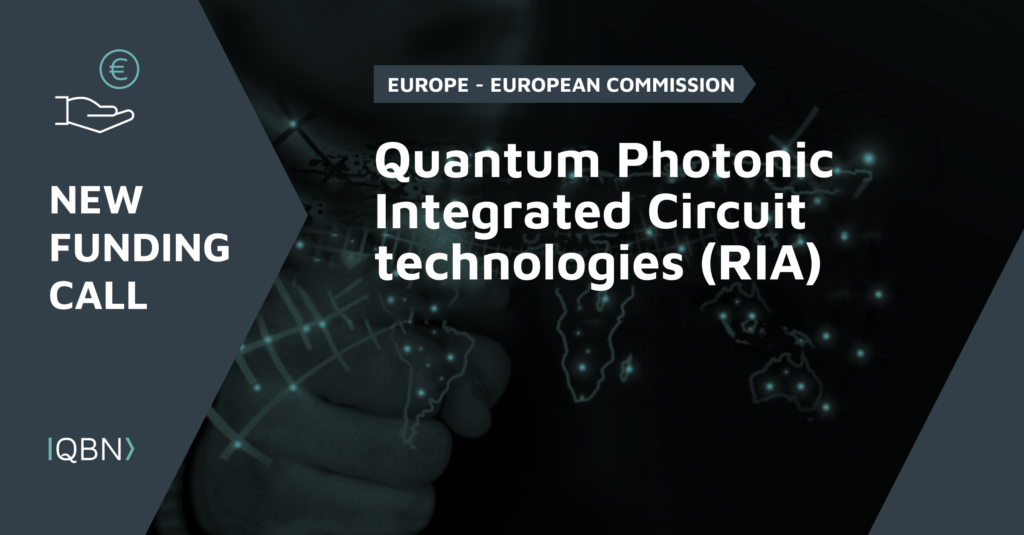Photonic Integrated Circuits (PIC) technologies on one side and quantum science on the other are the building blocks for development of Quantum PIC (QPIC) devices for quantum information processing, computation/simulation, communication, sensing or metrology. Photon-based approaches can address the huge challenge of implementing quantum processes in public infrastructures, challenging industry applications and compact everyday-life devices and products.
QPIC technology has great potentials to target several application fields, in particular, but not limited to, health care, communications, environment and security, and thus has high strategic significance and major implications for the European economy.
Expected Outcome:
- To improve over existing PIC technologies in terms of performance, functionality, manufacturing process efficiency and reliability, integration, and packaging in a manner that facilitates scalable manufacturing.
- To demonstrate the technology capability in key enabling Quantum PIC technologies with high potential impact on the quantum technology Industry, including applications in quantum sensing, communications, computation and simulation,
- Preparing QPIC technologies for future Pilot Lines and Photonics hubs and open testing and experimentation facilities,
- Exploit the potential of QPICs for a digital, green and healthy future in Europe by providing critical components and systems for next generation applications, products and processes. Develop tools for efficient design and prototyping of QPICs.
- Secure Technological Sovereignty for Europe by maintaining leadership in QPICs
- Contribution to the objectives of Digital Transformation, Green Deal, Competitiveness and Economic Growth.
Scope:
Proposals will address technology (up to TRL 4-5) in key enabling PIC technology applied to market needs. Objectives include:
- Enhancement of PIC performance, e.g. ultra-low loss; ultra-low laser linewidth; ultra-high extinction ratio modulators and switches , extending spectral and optical power coverage, optical coupling interfaces, packaging.
- Incorporation of specific quantum functionality into PIC platforms, e.g. single photon and entangled photon pair generation, single photon and photon number detection , quantum memory elements, quantum processors.
- Multi-technology integration, e.g. incorporation of ion/atomic traps and relevant control electronics, superconducting detectors, nonlinear elements, integration of photonic readout into quantum computing and sensing devices employing other technologies (e.g. electronic, spintronic), relevant passive and active linear optical elements (e.g. modulators, shifters, switches etc.) to underscore a strategy for modular QPIC design.
- Development of PICs capable of operating at cryogenic temperatures, with low power dissipation and performance optimized in the context of the operating environment.
- Development of the most promising methods for QPIC fabrication in monolithic, hybrid or heterogeneous integration techniques for different functionalities together with an identification of the most advantageous platform materials, (e.g. derived from “classical” PIC technologies such as Si, SiO2, Si3N4, InP, LiNbO3, Si-on-insulator, LiNbO3-on-insulator, Al2O3, AlN, hybrid platforms, etc. etc. etc.).
- Assembly and packaging of PICs, taking the specific challenges of quantum systems (environment, temperature, stability, visible and ultraviolet wavelengths requirements, vacuum integration) into account and including integration of complementary and ancillary technologies (e.g. microelectronics) where required
- Miniaturization of previously non-scalable quantum photonic systems by implementing them in PIC form.
Proposals should identify applications in quantum sensing, communication, computation and simulation. Proposals should test and evaluate the developed Quantum PIC technologies in the context of such specific applications though trials at systems level in a representative laboratory or an operational environment.
Deadline: 29 March 2023 17:00:00 Brussels time
For more information, please visit the European Commisssion website.



